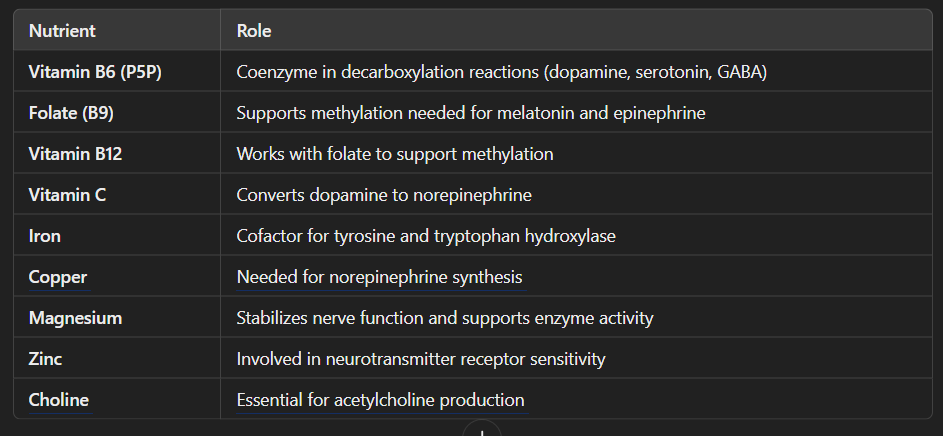Neurotransmitters are chemical messengers that help your brain and nervous system communicate. They influence everything from mood and memory to motivation, sleep, and stress resilience. You’ve probably heard of names like serotonin, dopamine, GABA, and norepinephrine—but where do they actually come from?
The answer: your body makes them, using amino acids from food, specific enzymes, and crucial vitamins and minerals. This process is called neurotransmitter synthesis, and when it’s working properly, your brain functions with clarity, balance, and emotional stability. When it's disrupted? Think brain fog, low mood, anxiety, or burnout.
In this article, we’ll break down how neurotransmitters are made, what nutrients they depend on, and what factors can interfere with their production.
The Basics: What Are Neurotransmitters?
Neurotransmitters are molecules that transmit signals between neurons. Some of the most important include:
- Dopamine – motivation, pleasure, focus
- Serotonin – mood, calm, sleep, digestion
- Norepinephrine – energy, alertness, stress response
- GABA – relaxation, calming the nervous system
- Acetylcholine – memory, learning, attention
- Glutamate – learning, stimulation, memory
Each neurotransmitter has a specific synthesis pathway, starting with an amino acid and requiring enzymes and cofactors like B-vitamins, magnesium, and iron to complete the process.
🧬 How Neurotransmitters Are Made
Let’s take a look at some major neurotransmitters and how they’re synthesized:
1. Dopamine → Norepinephrine → Epinephrine
Starting amino acid: Tyrosine (from protein or converted from phenylalanine)
Steps:
- Tyrosine → L-DOPA via tyrosine hydroxylase (requires BH4 + iron)
- L-DOPA → Dopamine via DOPA decarboxylase (requires vitamin B6)
- Dopamine → Norepinephrine (with copper + vitamin C)
- Norepinephrine → Epinephrine (with SAMe as methyl donor)
2. Serotonin → Melatonin
Starting amino acid: Tryptophan
Steps:
- Tryptophan → 5-HTP via tryptophan hydroxylase (requires BH4 + iron)
- 5-HTP → Serotonin (5-HT) via aromatic amino acid decarboxylase (vitamin B6)
- Serotonin → Melatonin (via methylation + acetylation)
3. GABA
Starting amino acid: Glutamate
Step:
- Glutamate → GABA via glutamate decarboxylase (requires vitamin B6)
4. Acetylcholine
Starting building blocks: Choline + Acetyl-CoA
Step:
- Combined by choline acetyltransferase
Nutrients needed: choline, pantothenic acid (B5), magnesium
🧪 Key Nutrients for Neurotransmitter Synthesis

🚫 What Can Disrupt Neurotransmitter Synthesis?
-
Poor diet (low in protein or B-vitamins)
-
Genetic variants (e.g., MTHFR, COMT, MAOA, GCH1)
-
Chronic stress (depletes nutrients and enzyme function)
-
Inflammation or oxidative stress
-
Digestive issues (reducing absorption of nutrients or amino acids)
-
Environmental toxins (heavy metals, pesticides)
-
Alcohol or drug use
Even a mild deficiency in one cofactor—like vitamin B6 or iron—can significantly reduce neurotransmitter levels.
🧬 Genes That Influence Neurotransmitter Balance

🧘♀️ How to Support Healthy Neurotransmitter Production
✅ Eat enough quality protein – for amino acid precursors (e.g. turkey, eggs, lentils)
✅ Get your B-vitamins – especially B6, B12, folate (preferably in active forms)
✅ Support your gut health – healthy digestion = better nutrient absorption
✅ Manage stress – mindfulness, sleep, breathing, nature
✅ Reduce toxin exposure – plastics, alcohol, pesticides
✅ Consider testing – look at your genetics, nutrient levels, or neurotransmitter profile (under professional guidance)
Conclusion
Neurotransmitters are the chemical messengers that shape how you think, feel, focus, and move through the world. And the good news is—your body makes them naturally, every day. But this complex process depends on your diet, your genes, your stress levels, and your ability to absorb key nutrients.
By understanding how neurotransmitters are made, and supporting the process with the right food, supplements, and lifestyle, you can profoundly impact your mental clarity, mood stability, and overall vitality—from the inside out.

